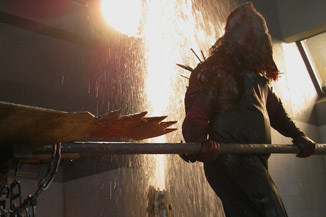What Went Right: Resident Evil Part II
By Shalimar Sahota
September 12, 2012
2009 saw the release of Resident Evil 5 on the PlayStation 3 and Xbox 360. With the game set in Africa, its generalization of racial stereotypes did not go down too well, with overblown issues of racism attracting controversy. A unique touch to the game was a co-op mode where a second player can join in. Players can heal each other and share weapons and ammo. It failed to reach the level of acclaim that was bestowed upon Resident Evil 4, but was still well received amongst gamers and critics. Many elements would find their way in the next film. Nintendo Wii owners were not left out, with The Umbrella Chronicles released in 2007 and The Darkside Chronicles in 2009. For anyone that couldn’t be bothered to play through the franchise’s back catalogue, both titles aimed to summarise the story and events of previous games for newcomers by condensing important plot elements into an on the rails shooter. As with most lightgun games, there is a co-op mode.
The biggest surprise came with the fourth film, Resident Evil: Afterlife, which became the highest grossing installment. One of the contributing factors to this was 3D. After the release of Avatar, 3D looked to be the next big thing, with almost every 3D film generating mega bucks. A brilliant teaser trailer for Afterlife made sure to mention that it was, “Filmed with the James Cameron / Vincent Pace Fusion camera system.” It was in odd thing to stick in a trailer, but it appeared to be speaking to those who had been let down by hasty 3D conversions, notably Clash of the Titans, which showed the world the difference between “shot in 3D” and “(badly) converted.” A 3D Resident Evil movie meant that fans weren’t going to wait to catch this on DVD. It had to be experienced on the big screen. With Anderson as writer, director and producer, the film went into production in September 2009 with an increased production budget of $60 million.
During a convention in April 2010, Sony’s Executive Deputy President, Hiroshi Yoshioka, spoke out against 3D conversions, saying, “Poorly executed 3D is harmful, and it threatens its long-term success…we must give consumers great 3D that looks natural and feels wonderful.” Afterlife became one of the films Sony used to help promote their range of 3D televisions. It also helped that it was a good-looking 3D film, utilising a lot of “in-your-face” effects.
There’s always an underground lab, and the film opens with Alice and her clones storming the Umbrella lab in Tokyo, Japan (the clones don’t last very long). Following this she makes her way to Alaska and reunites with Claire Redfield before the two fly to Los Angeles, meeting up with a small group of survivors. Thinking about it, seeing what Alice has had to go through since the first film, she’s actually had a pretty horrible life. Yet not once do we ever hear her complain and say how she wishes she were at home baking cakes.
Continued:
1
2
3
4
|
|
|
|




